The All-Clutch Team: Best (and worst) late-game performers of 2014-15

You know how Michael Jordan's jumper over Bryon Russell and Ray Allen's corner-pocket three stand among the most memorable moments in NBA history? You know how they showcase years of hard work and refined technique? How they combine grace under pressure and poetry in motion? And how they represent success in the face of rabid opponents and a ticking clock? Of course you do.
Now, do you know what’s not nearly as awesome as those shots? Getting lost in an endless debate about “clutch” play.
Can the league be divided into “clutch” players and “chokers”? Is a player born with a “clutch gene” or can he develop his late-game skills during his career? When does “crunch time” kick in: at the start of the fourth quarter, in the last five minutes, in the last minute, or on the final possession?
You can't blame many media members and observers for choosing to skip this discussion and all of its semantics. Although the voices claiming that “stats take the fun out of sports” often speak out of fear or ignorance, the obsessive “clutch” discussion has ballooned to the point where you can understand where the anti-numbers crowd is coming from. It should be alright to enjoy a Kobe Bryant game-winning floater on its merits, but doing so would border on an act of naivety for some viewers, who are keen to note that Bryant’s reputation as a go-to guy vastly exceeds his current late-game performance (36.8 percent shooting in clutch situations this season).
The following is SI.com’s “All-Clutch” Team, but this post is not intended to address the philosophical questions listed above, or to make character judgments, or to reference the past, or to predict the future. Rather, it’s an attempt to run down the top late-game performers through the first two-plus months of the 2014-15 campaign. Simply put: Who has been getting it done when the game is on the line this season?
•MORE NBA: New Year's resolutions for East teams | West teams
In weighing the candidates for this squad, a major goal was to expand the discussion past simply field goal percentage. A three-point specialist whose overall field goal percentage suffers because of his gift needs to be considered. A hard-charger who is skilled at drawing late-game fouls shouldn’t be overlooked. A multi-dimensional point guard should get credit for both his scoring and his passing when the game is on the line. Because we’re looking at a relatively small sample size – no one has played 25 games with “clutch” time yet – each player’s record in close games was also included as a factor the selection process.
Note: All stats through Jan. 6 and courtesy of NBA.com/stats. This post will use a broad definition of “clutch” time: the last five minutes of regulation (and overtime) when the score is within five points either way. Only players with at least 15 field goal attempts in the clutch were considered.
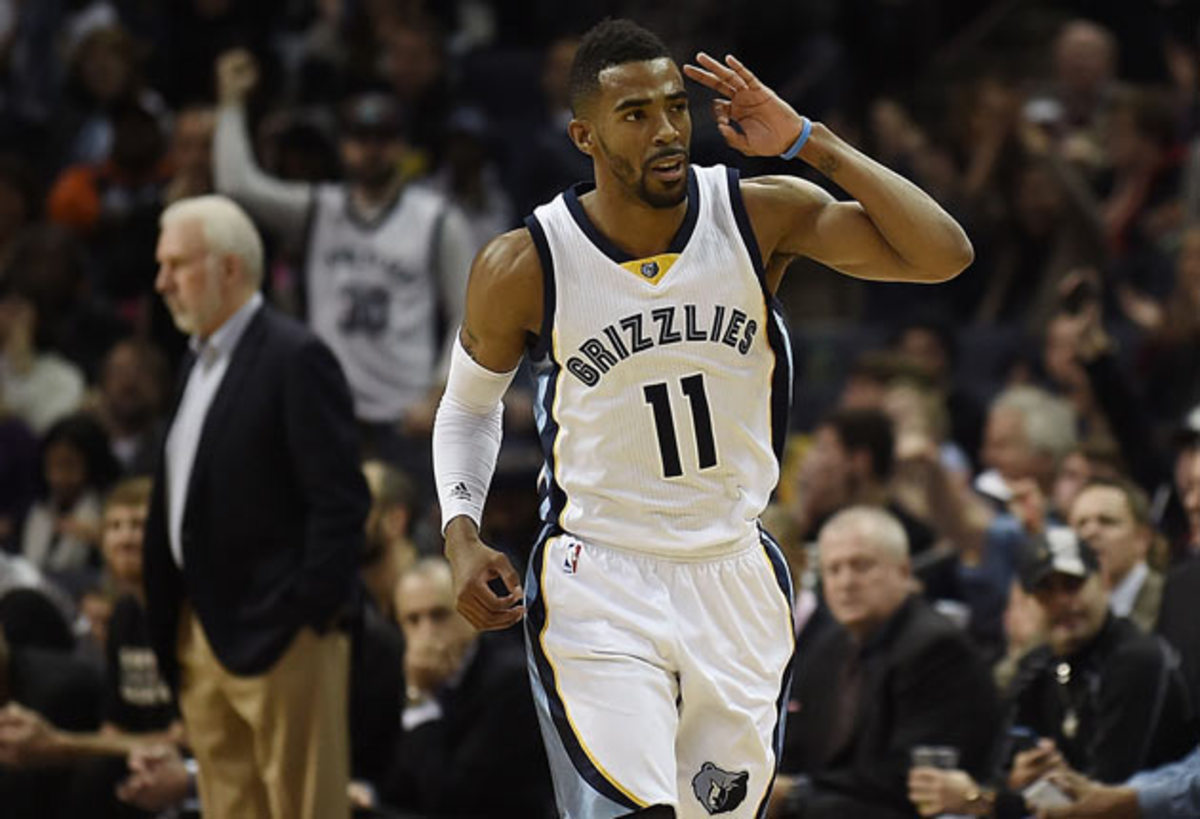
Guard: Mike Conley, Grizzlies
2014-15 Clutch Stats: 15-6 record, 26-of-55 shooting (47.3 percent), 9-of-17 three-point shooting (52.9 percent), 77 points, 16 assists, +21 plus/minus, 1.10 points per clutch possession
Referring to Conley as “The most underrated point guard in the league” gets to be kind of a mouthful, so maybe everyone can agree to call him something simpler, like “Money Mike.” Memphis possesses the West’s third-best record thanks in large part to a career year (18.1 points, 6.1 assists) from Conley, who unfortunately still runs the risk of being overlooked in the All-Star selection process once again.
Conley generally strikes a nice balance between controlled play and attack mode, and that skill doesn't abandon him late in games. He can beat defenses in a variety of ways: getting to the rim, hitting floaters, knocking down open shots, or making the right read to find the open man. A key weapon this season has been his outside shooting: Conley is connecting on 44.2 percent of his three-pointers overall and a ridiculous 52.9 percent in clutch situations (tops among point guards with at least six clutch three-point attempts). Below, find video of: 1) Conley sinking a deep bomb against the 76ers at the end of regulation, and 2) Conley sinking a huge three against the Spurs to save a scramble situation.
Conley’s 16 clutch assists trail only Ty Lawson (Nuggets), who has 20. The Grizzlies’ offense is ranked No. 8 this season, its best mark in more than a decade, and Conley has multiple options in crunch time. His favorite partner is Marc Gasol, to no one's surprise, and he’s an expert at sucking in and stringing out defenders before finding Gasol going to the basket or for a spot-up jumper. Here's an example from the Grizzlies' epic triple-overtime battle against the Spurs.
Hover over image to play
Honorable Mention: Damian Lillard, Blazers
Lillard’s developing reputation as an assassin was sealed for life when he knocked down a series-clinching three-pointer to eliminate the Rockets from the 2014 postseason. His eerie calm and love of the moment have continued this season: he’s shooting 6-for-15 (40 percent) from deep in the clutch and his 1.19 points per possession in the clutch is tops among point guards with at least 20 clutch shot attempts. Perhaps most impressive for a lead ball-handler: Lillard doesn’t have a single clutch turnover this season. The Blazers, who sit atop the Northwest Division, are 11-5 when Lillard plays in clutch situations.
Style points are Lillard's speciality. He provided one of the signature moments of the 2014-15 season when he tapped his wrist to ask the time – “Lillard Time” -- after nailing a key three in a come-from-behind win over the Thunder.
Clutch? Not So Much: Russell Westbrook, Thunder
Westbrook’s overall numbers have been out of the world this season (27 points, 7 assists, 5.6 rebounds, 2.2 steals), but he’s been pretty shaky late in games. Despite a 51.4 usage rate in the clutch (tops among qualified players, higher even than Bryant), Westbrook has shot 34.2 percent in clutch situations, he’s 0-for-8 on clutch three-pointers, he’s rarely gotten to the free throw line (just three attempts in the clutch), and he’s registered as many turnovers as assists in the clutch. All told, Westbrook has managed just 0.64 points per possession in the clutch, which places him alongside the dubious likes of Josh Smith, Tyreke Evans and Evan Turner.
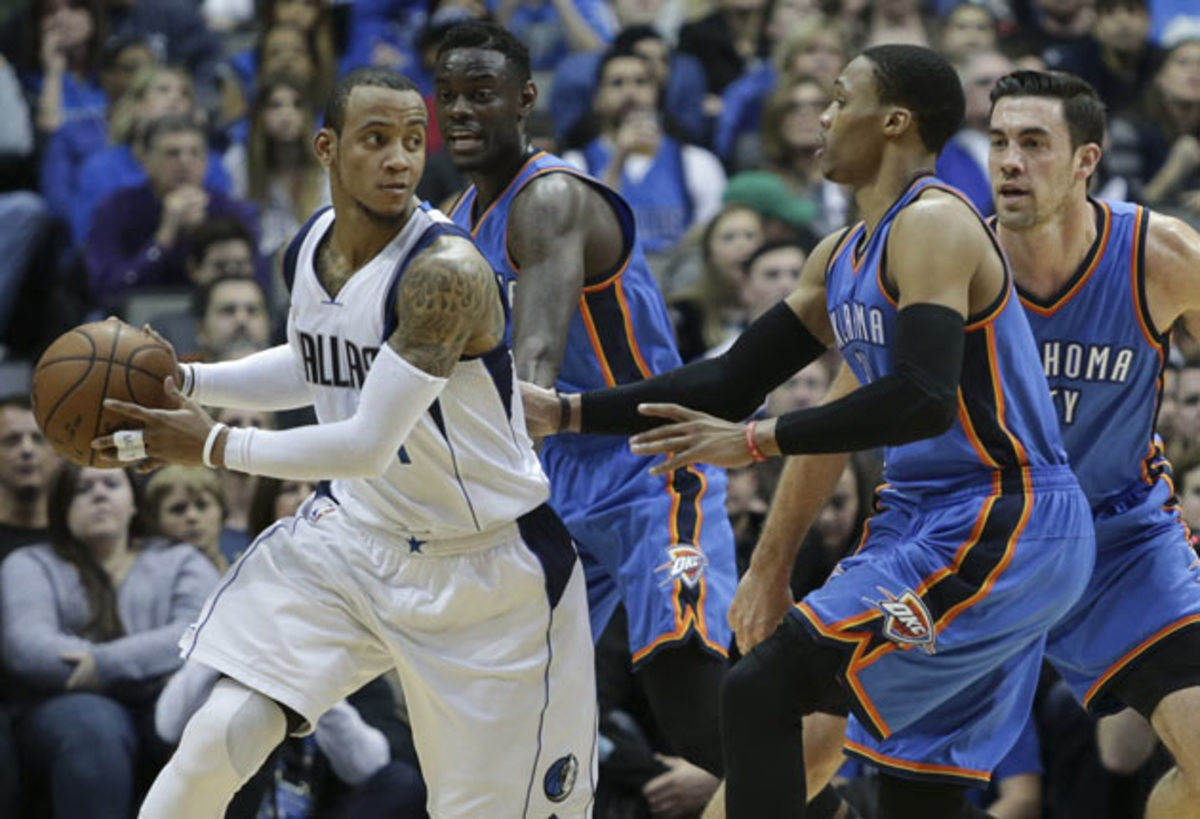
Guard: Monta Ellis, Mavericks
2014-15 Clutch Stats: 14-4 record, 27-of-50 shooting (54 percent), 3-of-9 three-point shooting (33.3 percent), 77 points, +53, 1.17 points per clutch possession
The Mavericks’ pretty record in close games has been a team effort: Dirk Nowitzki is shooting a sizzling 17-for-29 (58.6 percent) in the clutch and Chandler Parsons’ +59 in clutch situations leads all qualified players. Be sure to give the mercurial Ellis his due too. Ellis approaches potential game-winners with a puppy’s enthusiasm and a drunkard’s confidence, and he hit a “shot of the year” candidate to deliver a walk-off win over the Bucks.
Hero shots like that get the headlines, but Ellis also makes his mark by consistently delivering points from the charity stripe late in games. His quickness and body control make him a tough cover, and he’s not afraid to attack hard into the defense’s teeth. That fearlessness pays off in a number of helpful ways: he’s shooting 12-for-19 (63.2 percent) in the basket area during clutch situations, he’s drawn more fouls in the clutch this season (19) than any player besides Kobe Bryant (22), and his 24 clutch free-throw attempts places him in the top 10 of qualified players (trailing the likes of Bryant, James Harden, and Manu Ginobili). Below, he gets to the rack with ease in the final minute of regulation against the Spurs.
In sum, his knifing takes help set the table for Nowitzki, Parsons and the rest of coach Rick Carlisle’s No. 1 ranked offense. Will this be the year that Ellis fills out his reputation by delivering victories in the postseason?
Honorable Mention: Danny Green, Spurs
Weighing the relative merits of Ellis (an inside-out, ball-in-hands scorer) and Green (an outside-out, catch-and-shooter) is a perfect reminder that “clutch” comes in all stripes. A team of Harvard scientists is hard at work in a laboratory right now attempting to determine whether Green has ever actually missed an open jumper when it mattered. Green burst onto the national stage by hitting 48.2 percent of his threes in the 2013 playoffs and 47.6 percent of his threes in the 2014 playoffs; he’s torching the nets again this season to the tune of 9-for-16 (56.3 percent) on clutch threes.
Green’s 1.39 points per possession in the clutch ranks No. 2 overall. That marks is tops among all perimeter players, including Jimmy Butler, Klay Thompson and James Harden, three other shooting guards who are excelling in late-game situations. He might need someone to set the table, but Green handles the rest with the best of them.
Clutch? Not So Much: Kemba Walker, Hornets
Walker has a reputation as a shot-maker, and he has delivered a number of game-winning shots this season and had a memorable clutch run at UConn. On the whole, though, he’s simply doing too much in Charlotte. The damage is significant: Walker is shooting 28.8 percent in clutch situations while hoisting more often than everyone besides Bryant. He is hitting just 27.8 percent from deep. Somehow, Walker has actually had his shot blocked more often (eight times) than he has registered an assist (seven) in late-game situations. Walker’s 0.76 points per possession and -36 clutch plus/minus rank near the very bottom among qualified players. New teammate Lance Stephenson was supposed to help carry the load, but "Born Ready" has shot just 3-for-15 (20 percent) in clutch situations as he struggles to find a fit in coach Steve Clifford’s late-game lineups and strategies.
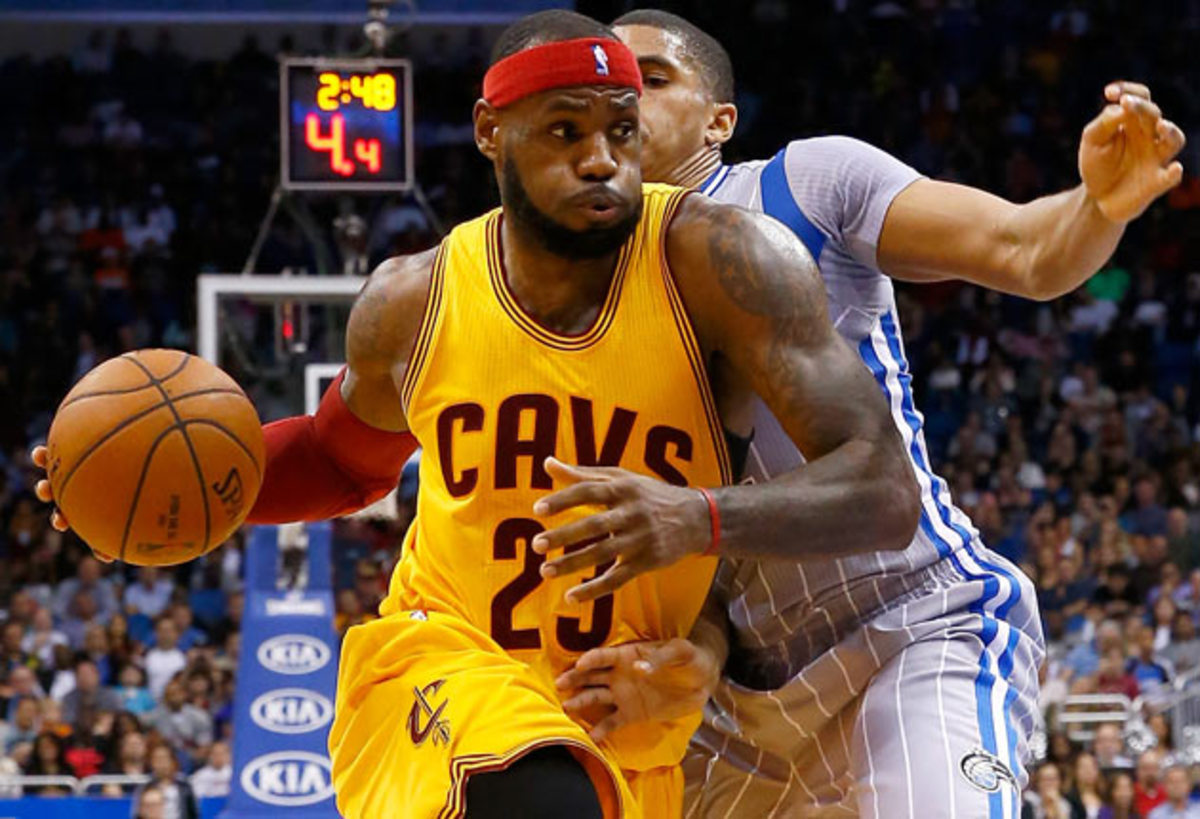
Forward: LeBron James, Cavaliers
2014-15 Clutch Stats: 8-4 record, 17-of-33 shooting (51.5 percent), 4-of-10 three-point shooting (40 percent), 62 points, 8 assists, +41, 1.19 points per clutch possession
LeBron has really run the “clutch” gauntlet during his career, drawing heat for everything from passing too often, to missing free throws, to suffering from leg cramps. Regardless, his track record of winning and his historical statistical output has managed to satisfy all but his most delusional critics. This year has seen continued excellence from the four-time MVP. His new Cavaliers team might not be very good at defense, they might not be very deep, and they might be prone to huge swings when it comes to the quality of their play, but they have predictably done quite well in close games with James in the lineup.
If there’s one thing for younger players to take from James’ late-game approach, it’s that he keeps all of his tools in his belt. He is usually careful to avoid over-relying on isolation situations, and if he does opt to go one-on-one he often does so by going hard to the hoop. James is tied with James Harden with the most clutch free throw attempts this season (30) and he’s a master at generating high-percentage looks with his broad shoulders and balance. Here, he seals a win over the Magic by getting deep into the paint.
Hover over image to play
Of course, going to the basket also opens up his other major weapon: a Magic Johnson-like ability to read the defense and find the open man. Below, all eyes turn to James as he works towards the hoop, clearing him to whip a crosscourt pass to Kevin Love for an open three.
Hover over image to play
Throw in the improvements James has made to his shooting range in recent years and he remains the league’s most dangerous weapon, even if he has appeared to slip a touch during his age-30 season. James’ 1.19 points per possession in the clutch is tops among frontcourt players with at least 30 field goal attempts.
Honorable Mention: Dirk Nowitzki, Mavericks
Much like James, Nowitzki silenced the doubters who questioned his make-up and style of play once he won a title. The big German forward will be remembered as one of the league’s greatest all-time scorers and shooters, and he’s not slowing down quite yet. At 36, Nowitzki is shooting nearly 60 percent in clutch situations, and his 1.37 points per possession in the clutch ranks third in the NBA. Those numbers are made that much more eye-popping when you realize that only one of his 29 clutch field goal attempts has come in the basket area. His clutch shot chart is greener than a freshly-watered soccer field, as he snipes from virtually anywhere on the court.
Clutch? Not So Much: Josh Smith, Rockets
Truly shocking news: Smith is a terrible shooter in the clutch, just like every other time of the game. The numbers pretty much tell this tale by themselves: 30.3 percent shooting, 11.1 percent three-point shooting, and 41.7 percent free-throw showing. Detroit is the toast of the league thanks to a 6-0 record since cutting Smith, and they certainly don’t miss his atrocious 0.65 points per possession in the clutch or his -42 plus/minus in the clutch, which just so happens to be the league’s worst mark. Rockets GM Daryl Morey made an opportunistic move in scooping up Smith, but in doing so he put serious pressure on coach Kevin McHale to figure out how to best use a player that so badly killed the Pistons when games were on the line.
Next page: Power forward and Center: Most clutch players?
[pagebreak]
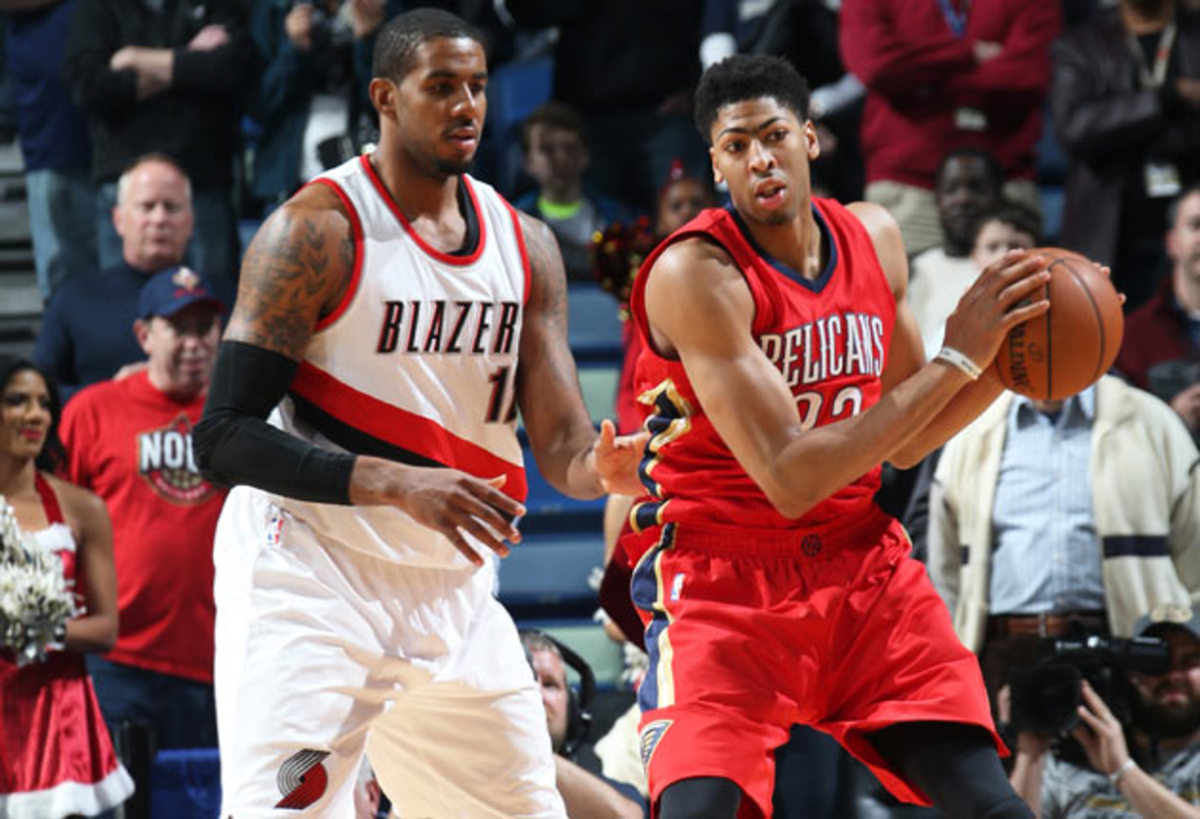
Forward: Anthony Davis, Pelicans
2014-15 Clutch Stats: 6-8 record, 18-of-20 shooting (90 percent), 46 points, 18 rebounds, -4, 1.82 points per clutch possession
How fantastic is Davis? He’s so fantastic that he’s an MVP candidate and the NBA’s leader in Player Efficiency Rating even though he is – by far – the most underutilized late-game weapon in the NBA today. Davis is the atomic bomb of late-game weapons, really, as his numbers annihilate the competition. Most impressive: his league-leading 1.81 points per possession in the clutch is leaps, and leaps, and leaps and bounds ahead of Green, who ranks second at 1.39. And then there’s his too-big-to-believe 90 percent shooting from the field, which again blows away the rest of the league (Pau Gasol ranks second among qualified players at 63 percent). Davis also ranks seventh in clutch rebounds and has committed a grand total of zero turnovers in clutch situations this season, even though he is still just 21 years old.
To recap: in clutch situations, Davis makes nearly every shot he takes, he rebounds in volume, he rarely makes mistakes, and he produces points at a rate that makes him look like a fully-grown man competing against sixth graders. Come to think of it, “atomic bomb” might actually be underselling his impact.
It's a shame that Davis isn't featured nearly enough by coach Monty Williams when the game is on the line. In fact, Tyreke Evans leads the Pelicans in clutch attempts (32), even though he is connecting on a pitiful 21.9 percent of those shots. What’s more, Jrue Holiday and Ryan Anderson have each taken nearly as many clutch shots as Davis. If ever there was a player to force-feed with the game on the line, it would be Davis, who is money in the basket area, on mid-range jumpers, and from the free-throw line. Instead, he waits in a hangar near Roswell, New Mexico, hoping that someone will eventually unleash him with an eye towards improving New Orleans’ middling record in close games. The kaboom is coming.
Honorable Mention: LaMarcus Aldridge, Blazers
Aldridge, like Nowitzki before him, has heard critics charge him with being too jumper-oriented to carry his team deep into the postseason. The "L-Train" found new respect and his first playoff series victory when he torched the Rockets last spring, and he’s clicking on all cylinders so far this season. Teaming with Lillard and a well-balanced starting lineup to lead Portland to the West’s second-best record to date, Aldridge ranks in the top 20 in clutch points, the top five in clutch rebounds, and the top 12 in plus/minus during clutch situations. The long, smooth forward gets it done with his bread-and-butter turnaround and an array of moves from his preferred left block. Although he’s dealt with some questionable free-throw shooting in the past, he’s hit 15 of his 16 clutch free throw attempts this season, which helps make up for his dependence on long twos. Aldridge’s 1.06 points per possession in the clutch puts him near the top of the league’s charts at his position.
Clutch? Not So Much: Rudy Gay, Kings
You almost have to admire Gay’s ability to tune out the rest of the world when he digs in for late-game isolations that are headed nowhere fast. A piercing record-scratch warns the rest of the Earth’s inhabitants of danger, and yet there goes Gay, oblivious to his surroundings once again, pounding the air out of the ball and forcing up a bad shot. Hey, it’s not like he has a seven-footer with elite skills to help him out or anything...
Gay’s crunch time numbers are as unwatchable as you might expect: 25.8 percent shooting, ZERO percent three-point shooting (0-for-8), more turnovers (7) than assists (6), a -31 plus/minus, and an unsightly 0.65 points per possession mark that is only a small fraction better than Smith’s mark. As Kings owner Vivek Ranadive works to find his “jazz director” to run his preferred offense, he should first hire a security guard whose sole job is to tackle Gay whenever he gets the urge to go one-on-five for all the marbles.
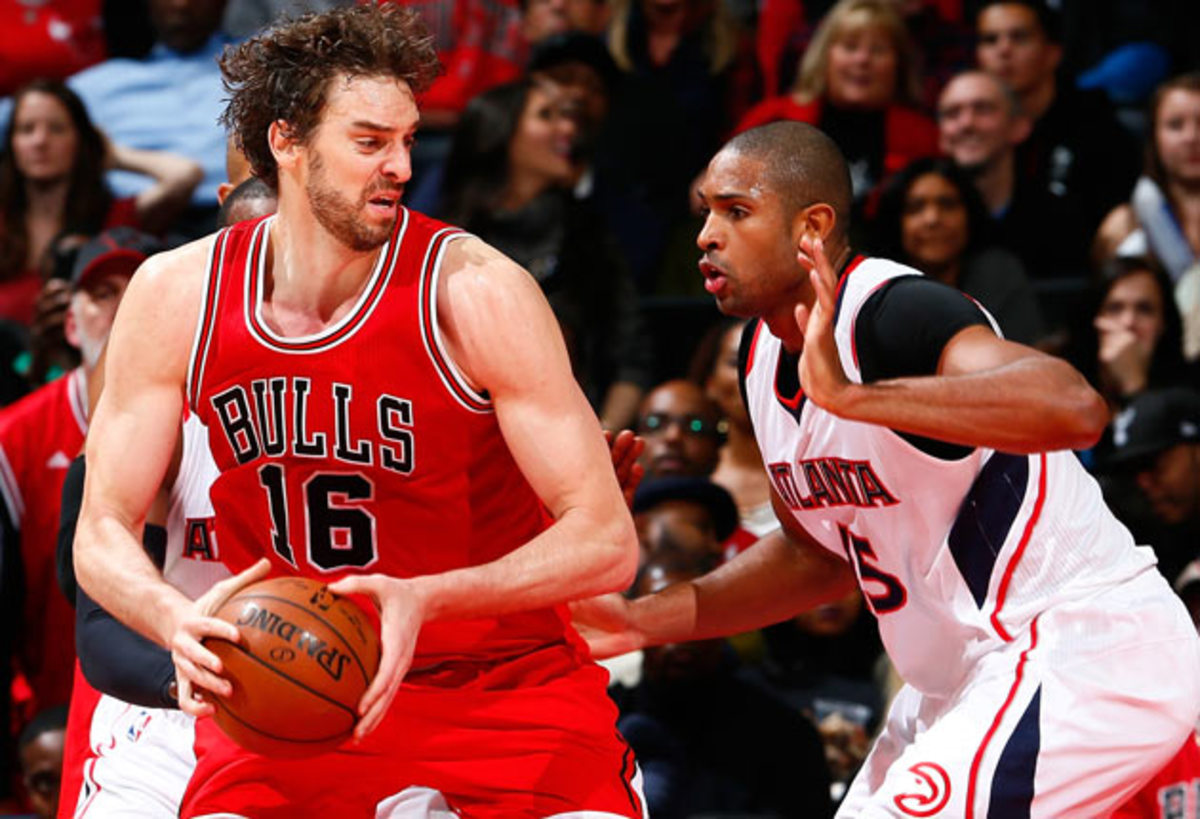
Center: Pau Gasol, Bulls
2014-15 Clutch Stats: 16-5 record, 17-of-27 shooting (63 percent), 54 points, 17 rebounds, six assists, +39, 1.33 points per clutch possession
To no one’s great surprise, the clutch scoring charts are dominated by perimeter players. Aside from Zach Randolph and Al Jefferson, the 50 players with the most clutch field goal attempts are either guards, forwards, or big men who spend a significant portion of their time away from the hoop (Aldridge, Nowitzki, Davis, etc.).
Gasol clearly has the inside/outside versatility needed to be an active threat late in games. The question for the 34-year-old Spaniard in recent years has really been whether the game was passing him by. Leaving the Lakers for the Bulls was clearly the right call: Gasol ditched second/third/fourth fiddle status on a team going nowhere for a major role on a title contender. He looks more engaged than he has in years and Chicago ranks among the East’s top teams thanks to their strong record late in games.
Gasol has helped Butler, a breakout star, carry the early-season load late in games. Here, the duo plays a little two-man game that sees Gasol pass, move, set a screen and duck to the hoop for a soft touch shot in the paint. You have to admire the fluidity.
Hover over image to play
There’s a little bit of everything going on late in games for Gasol, who is scoring inside and out, hitting the boards, moving the ball and he’s getting to the line. Below, watch him attract extra attention before finding Joakim Noah on a big-to-big pass that ends with a dunk. Add it all up, and Gasol's 1.33 points per possession in the clutch trails only Davis and Nowitzki among frontcourt players. Like Jefferson and Paul Millsap before him, Gasol’s move from West to East has meant a return to relevance that could very well land him back in the All-Star Game for the first time since 2011.
Hover over image to play
Honorable Mention: DeMarcus Cousins, Kings
An extended illness and a silly coaching saga shouldn’t dampen the enthusiasm around Cousins, who continues to make a beeline towards superstardom. The beastly center is averaging career-highs (23.5 points, 12.1 rebounds, 1.5 blocks, 26.5 PER) and he is flashing “total takeover” potential. The highlights have been few and far between during Sacramento’s current 3-10 stretch, but Cousins made his presence known recently with a slick drive and dunk to sink New York in overtime. That sequence showcased his natural basketball instincts, his speed and his power all at once, with the game still in the balance.
One of interim coach Tyrone Corbin’s top priorities the rest of the way should be featuring Cousins much more heavily late in games. In limited minutes, Cousins is producing a solid 1.07 points per clutch possession while shooting 47 percent from the field and getting to the line with regularity. This should be a straightforward fix: downshift with Gay, then accelerate with Cousins.
Clutch? Not So Much: Nikola Vucevic, Magic
There can’t be too many complaints about Orlando’s late-game performance, not when forward Tobias Harris has burst onto the scene with multiple game-winners and strong late-game shooting numbers. The Magic are also clearly at the mercy of a young backcourt that’s still in the process of getting its sea legs. Still, Vucevic’s career-high 52.3 percent shooting this season dips to just 35.3 percent (6-for-17) during clutch situations, and he hasn’t made a single clutch shot from outside the basket area this year. Vucevic really hasn’t registered much of an impact on the glass late in close games, either. It’s not often that you see a skilled, hardworking player averaging 17.9 points and 11 rebounds per game become this invisible. Orlando needs more from its $53 million man going forward.
